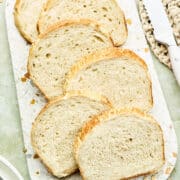Porridge Bread
Inspired by Cape Breton tradition, this homemade porridge bread combines creamy cooked oats and maple syrup for a soft, golden loaf.
Servings: 10 servings
Calories: 192kcal
Equipment
- Digital kitchen scale or measuring cups and spoons
- Small saucepan
- Mixing bowl
- Danish dough whisk or sturdy spoon
- Clean shower cap or tea towel
- 2 9 x 5-inch (23 x 13 cm) loaf pans
- Parchment paper
- Pastry brush
- Oven thermometer
- Wire rack
Ingredients
- ⅓ cup rolled oats not quick oats
- 1 ⅔ cups warm water divided
- 2 tablespoon salted butter divided
- 2 tablespoons maple syrup pure
- 1 ¼ teaspoon active dry yeast not rapid rise
- 1 tablespoon granulated sugar divided
- 1 teaspoon salt
- 3 cups all-purpose flour plus extra for kneading
Instructions
- In a small saucepan, combine the rolled oats with ⅔ cup (166 g) of water and the maple syrup. Cook over medium heat, stirring frequently, until the oats are soft and the mixture is thick and creamy, about 5 to 7 minutes. Allow the porridge to cool completely to room temperature.
- Melt 1 tablespoon of the butter and set it aside.
- Pour ¼ cup (63 g) of warm water into a mixing bowl. Add the yeast and ½ teaspoon of the granulated sugar, stir to combine, and let sit for 10 minutes or until frothy.
- Add the remaining ¾ cup (188 g) of warm water, plus the remaining sugar, salt, and melted butter to the bowl. Stir to combine, then add the cooled porridge and mix well to incorporate.
- Add the flour and stir until a shaggy dough forms. Continue stirring until all dry bits of flour are incorporated.
- Turn the dough onto a lightly floured surface and knead by hand for 10 minutes, adding a sprinkle of flour anytime the dough sticks to the surface or your hands. The dough should feel smooth, elastic, and slightly tacky but not sticky.
- Shape the dough into a ball and place it back in the mixing bowl. Cover the bowl with a shower cap or a damp tea towel and let it rise in a warm place for about 1 hour, or until doubled in size.
- Line a standard 9 x 5 inch (23 x 13 cm) loaf tin with parchment paper.
- Gently punch down the dough and turn it out onto a work surface. Divide the dough into two portions and form each into a smooth ball. Place the balls side by side in the prepared loaf pan. Cover the pan and let the dough rise for another 45 minutes, or until it rises about 1 inch (3 cm) above the pan’s rim.
- Preheat the oven to 425°F (190°C) and melt the second tablespoon of butter. Brush both dough balls with the butter and then cover the tin with a second upside-down loaf tin, like a cover. Bake the loaf for 20 minutes. Carefully remove the top tin cover and bake for 5 to 10 minutes more, or until the top sounds hollow when tapped and the crust is golden. Remove from the pan and cool on a wire rack for 3 to 4 hours before slicing.
Notes
- Ensure the cooked oats cool completely before adding them to the dough to prevent interfering with the yeast activity.
- If the yeast doesn’t look frothy after proofing, it may have expired, or the water might have been too hot or cold. Start again with fresh yeast.
- Cover the dough loosely when rising to avoid sticking and allow room for expansion.
- The top of the loaf may crackle after cooling. This is normal.
Storage
- Store the bread in an airtight container or resealable bag at room temperature for up to 2 days. For longer storage, slice and freeze the bread in a freezer-safe bag for up to 2 months. Thaw slices at room temperature or warm them briefly in the toaster.
Nutrition
Serving: 1serving | Calories: 192kcal | Carbohydrates: 36g | Protein: 5g | Fat: 3g | Saturated Fat: 2g | Polyunsaturated Fat: 0.3g | Monounsaturated Fat: 1g | Trans Fat: 0.1g | Cholesterol: 6mg | Sodium: 254mg | Potassium: 66mg | Fiber: 1g | Sugar: 4g | Vitamin A: 70IU | Vitamin C: 0.001mg | Calcium: 14mg | Iron: 2mg
